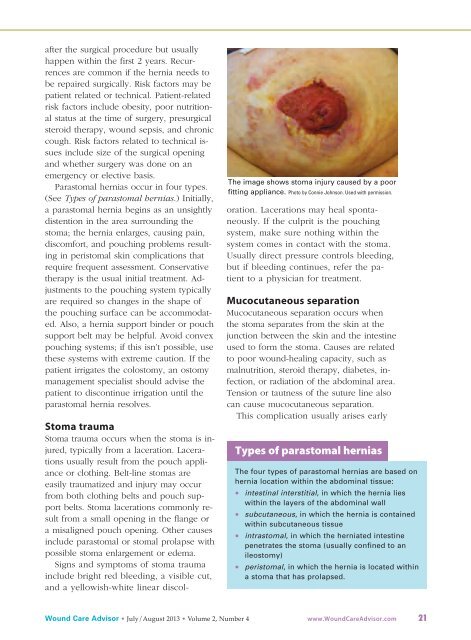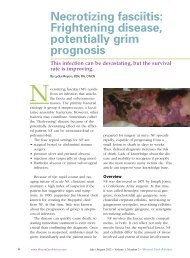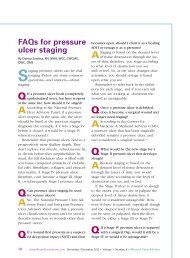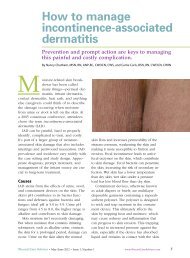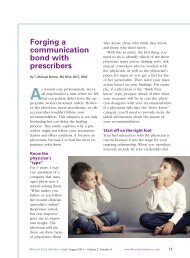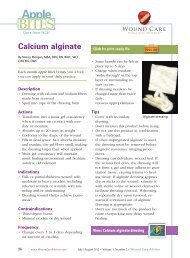ALC Cover Jan/Feb - Wound Care Advisor
ALC Cover Jan/Feb - Wound Care Advisor
ALC Cover Jan/Feb - Wound Care Advisor
Create successful ePaper yourself
Turn your PDF publications into a flip-book with our unique Google optimized e-Paper software.
after the surgical procedure but usually<br />
happen within the first 2 years. Recurrences<br />
are common if the hernia needs to<br />
be repaired surgically. Risk factors may be<br />
patient related or technical. Patient-related<br />
risk factors include obesity, poor nutritional<br />
status at the time of surgery, presurgical<br />
steroid therapy, wound sepsis, and chronic<br />
cough. Risk factors related to technical issues<br />
include size of the surgical opening<br />
and whether surgery was done on an<br />
emergency or elective basis.<br />
Parastomal hernias occur in four types.<br />
(See Types of parastomal hernias.) Initially,<br />
a parastomal hernia begins as an unsightly<br />
distention in the area surrounding the<br />
stoma; the hernia enlarges, causing pain,<br />
discomfort, and pouching problems resulting<br />
in peristomal skin complications that<br />
require frequent assessment. Conservative<br />
therapy is the usual initial treatment. Adjustments<br />
to the pouching system typically<br />
are required so changes in the shape of<br />
the pouching surface can be accommodated.<br />
Also, a hernia support binder or pouch<br />
support belt may be helpful. Avoid convex<br />
pouching systems; if this isn’t possible, use<br />
these systems with extreme caution. If the<br />
patient irrigates the colostomy, an ostomy<br />
management specialist should advise the<br />
patient to discontinue irrigation until the<br />
parastomal hernia resolves.<br />
The image shows stoma injury caused by a poor<br />
fitting appliance. Photo by Connie Johnson. Used with permission.<br />
Stoma trauma<br />
Stoma trauma occurs when the stoma is injured,<br />
typically from a laceration. Lacerations<br />
usually result from the pouch appliance<br />
or clothing. Belt-line stomas are<br />
easily traumatized and injury may occur<br />
from both clothing belts and pouch support<br />
belts. Stoma lacerations commonly result<br />
from a small opening in the flange or<br />
a misaligned pouch opening. Other causes<br />
include parastomal or stomal prolapse with<br />
possible stoma enlargement or edema.<br />
Signs and symptoms of stoma trauma<br />
include bright red bleeding, a visible cut,<br />
and a yellowish-white linear discoloration.<br />
Lacerations may heal spontaneously.<br />
If the culprit is the pouching<br />
system, make sure nothing within the<br />
system comes in contact with the stoma.<br />
Usually direct pressure controls bleeding,<br />
but if bleeding continues, refer the patient<br />
to a physician for treatment.<br />
Mucocutaneous separation<br />
Mucocutaneous separation occurs when<br />
the stoma separates from the skin at the<br />
junction between the skin and the intestine<br />
used to form the stoma. Causes are related<br />
to poor wound-healing capacity, such as<br />
malnutrition, steroid therapy, diabetes, infection,<br />
or radiation of the abdominal area.<br />
Tension or tautness of the suture line also<br />
can cause mucocutaneous separation.<br />
This complication usually arises early<br />
Types of parastomal hernias<br />
The four types of parastomal hernias are based on<br />
hernia location within the abdominal tissue:<br />
• intestinal interstitial, in which the hernia lies<br />
within the layers of the abdominal wall<br />
• subcutaneous, in which the hernia is contained<br />
within subcutaneous tissue<br />
• intrastomal, in which the herniated intestine<br />
penetrates the stoma (usually confined to an<br />
ileostomy)<br />
• peristomal, in which the hernia is located within<br />
a stoma that has prolapsed.<br />
<strong>Wound</strong> <strong>Care</strong> <strong>Advisor</strong> • July/August 2013 • Volume 2, Number 4 www.<strong>Wound</strong><strong>Care</strong><strong>Advisor</strong>.com 21


